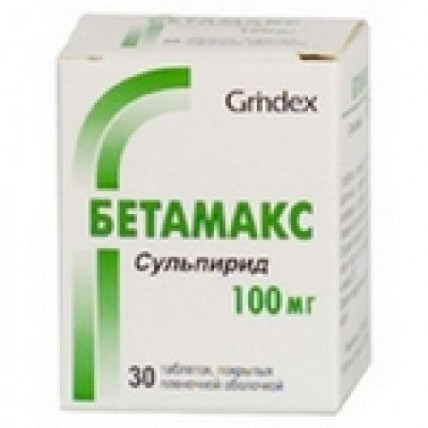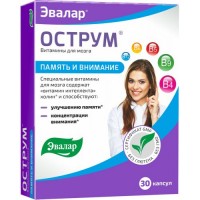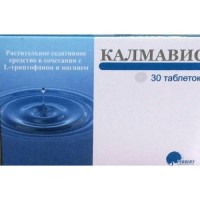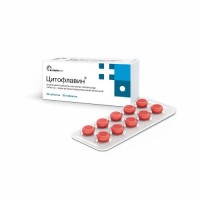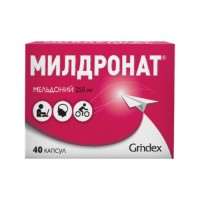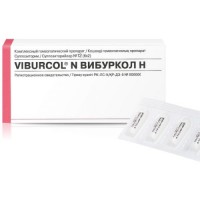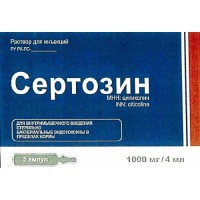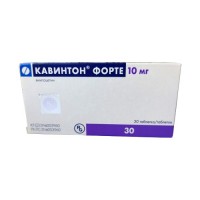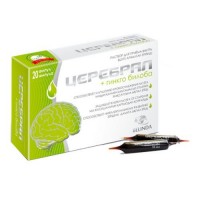BETAMAX® (Sulpirid) 100 mg, 30 coated tablets
- $22.00
The instruction for medical use of medicine BETAMAKS the Trade name BETAMAKS the International unlicensed name Sulpiridum Dosage Form of the Tablet, film coated 50 mg, 100 mg, 200 mg Structure One tablet contains active agent – Sulpiridum of 50 mg or 100 mg, or 200 mg, excipients: kernel: povidone, magnesium stearate, krospovidon, starch corn, cellulose microcrystalline, cover: dye 33G28707 Opadray white (gipromelloza (E 464), titan dioxide (E 171), lactoses monohydrate, triacetin, macrogoal 3000), karnaubsky wax. Description Round biconvex tablets, film coated white or almost white color. On the place of a break white. Pharmacotherapeutic group Psychotropic drugs. Neuroleptics. Benzamides. Sulpiridum. ATH code: N05AL01 the Pharmacological Pharmacokinetics Absorption Later properties of an intramuscular injection of 100 mg of Sulpiridum the maximum concentration in plasma (Cmax) of 2.2 mg/l is reached within 30 minutes. After oral administration Sulpiridum is soaked up within 4.5 hours. For an oral dose of 200 mg (tablet) Cmax makes 0,5 1,8 mg/l. Distribution Bioavailability of the dosage form applied inside makes 25% of-35% with big variations between individuals. Sulpiridum level in plasma is proportional to a dose. Sulpiridum is quickly distributed in body tissues, especially in a liver and kidneys. There is a small diffusion in a brain. Less than 40% contact proteins of plasma. Speed of distribution of erythrocytes in plasma is 1. Metabolism Sulpiridum is badly metabolized in an organism. Removal Sulpiridum is brought out of an organism generally through kidneys by glomerular filtration. The renal clearance is usually equal to the general clearance. 92% of an intramuscular dose are removed with urine in not changed look. The quantity which is removed with mother's milk is 1/1000 from a daily dose. The half-cycle of removal makes 7 hours. The volume of distribution is 0.94 l/kg (0.6-1.5 l/kg). The general clearance is 126 ml/min. The pharmacodynamics Sulpiridum specifically antagonizirut D2 and D3 dopamine receptors. At patients with the psychotic disturbances causing negative symptoms, Sulpiridum is effective in doses from 150 to 600 mg/day. In this range of doses Sulpiridum practically does not influence positive symptoms. Doses from 600 to 1600 mg/day improve positive symptoms at patients with acute and chronic psychoses. Only very high doses of Sulpiridum cause sedative action. Indications - treatment of depressive disturbances with psychotic symptoms in a combination with antidepressants if treatment only antidepressants was inefficient, treatment of other serious forms of a depression resistant to antidepressants - treatment of vertigo in cases if there was no reaction to standard treatment of vertigo - treatment of acute and chronic psychoses Apply the Route of administration and doses inside, it is desirable before food, swallowing a tablet entirely. Doses choose individually, depending on the nature of a disease and symptoms, in view of age of the patient, body weight and the general state. Adults divide the Daily dose into three receptions during the day. The recommended doses make: - 150,300 mg/days at depressive disturbances with psychotic symptoms and vertigo. - 200-1600 mg/days in acute and chronic psychoses. Treatment of acute and chronic psychoses should be begun with the injected Sulpiridum solution. Children and teenagers aged up to 18 years Efficiency and safety of Sulpiridum at children and teenagers are completely not studied. Therefore its use is contraindicated in this group of patients. Patients with a renal failure In a renal failure the dose should be picked up according to clearance of creatinine. Reduction of a dose can be 35-70% as it is specified further: - clearance of creatinine of 30-60 ml/min. – apply 50-70% of a usual daily dose - clearance of creatinine of 10-30 ml/min. – apply 35-50% of a usual daily dose - clearance of creatinine & lt, 10 ml/min. – apply concentration of Sulpiridum in plasma can be increased to 35% of a usual daily dose Elderly patients At elderly patients. Therefore the smaller initial dose and more gradual selection of a dose can be required by these patients. Sudden phase-out of medicine can cause appearance of nausea, vomiting, perspiration, insomnia, concern and autokinesias. Use of medicine should be stopped, gradually reducing a dose. Side effects the mentioned side effects are ordered further according to the database of classification of systems of bodies and frequencies of MedDRA: very often (≥1/10), it is frequent (≥1/100 to & lt, 1/10), infrequently (≥1/1000 to & lt, 1/100), is rare (≥1/10,000 to & lt, 1/1000), is very rare (& lt, 1/10,000), it is unknown (it is impossible to determine by the available data). Disturbances from blood and lymphatic system Infrequently: leukopenia. It is unknown: neutropenia and agranulocytosis. Disturbance from the immune system Is unknown: anaphylactic reactions (urticaria, short wind, hypotension and acute anaphylaxis). Disturbances from an endocrine system Often: giperprolaktinemiya. Disturbances from mentality Often: insomnia. Disturbances from nervous system Often: a sedation or drowsiness, extrapyramidal disturbances (these symptoms usually reversible at use of antiparkinsonichesky means), parkinsonism, a shiver, an akathisia. Infrequently: hypertensia, dyskinesia, dystonia. Seldom: autokinesias of eyeballs, usually up. It is unknown: spasms, a malignant antipsychotic syndrome, a hypokinesia, late dyskinesia which is characterized by the rhythmic not conscious movements of a face and/or language (also as with other antipsychotic means after use more than 3 months). Antiparkinsonichesky drugs are inefficient or can cause deterioration in symptoms. Also as at all neuroleptics, the malignant antipsychotic syndrome is potentially lethal complication. Dysfunctions of heart it is rare: ventricular arrhythmia, ventricular tachycardia, ventricular fibrillation. It is unknown: lengthening of an interval of QT in the electrocardiogram, cardiac arrest, torsades de pointes, sudden death. Disturbances from a blood system Seldom: orthostatic hypotension. It is unknown: a venous thrombembolia, an embolism of lungs (sometimes with a lethal outcome), a deep vein thrombosis and the increased blood pressure. Disturbances from digestive tract Infrequently: the increased salivation. Disturbances from a liver and/or a bile-excreting system Often: superactivity of transaminases of a liver. Injuries of skin and hypodermic fabrics Often: makulopapulezny rashes. Damage of the skeletal and muscular and accompanying system Is unknown: rigidity of a throat and throat. Pregnancy, puerperal and the perinatal period It is unknown: extrapyramidal symptoms, a withdrawal of drugs at newborns. Diseases of a reproductive system and a breast it is frequent: galactorrhoea, stethalgia. Infrequently: amenorrhea, increase in a breast, disturbance of an orgasm and erectile function. It is unknown: gynecomastia. The general disturbances and changes in the injection site it is frequent: increase in weight. Contraindications - hypersensitivity to active agent or to any excipient of drug - arterial hypertension of the II-III degree - maniacal psychosis - a pheochromocytoma - Parkinson's disease - epilepsy - a sharp porphyria - oppression of the central nervous system (CNS) - comas - oppression of marrow - prolaktinzavisimy tumors (including. breast cancer) - a giperprolaktinemiya - patients in the heat of passion and aggression which have a danger of provocation of symptoms - patients with lengthening of an interval of QT, for example, with a congenital syndrome of the extended QT interval, or the clinical situations causing additional risk, for example: - clinically significant bradycardia (& lt, 50 beats per minute), - symptomatic arrhythmia in the anamnesis, - any other clinically significant heart trouble, - simultaneous treatment with antiarrhytmic means of the I or III classes, - simultaneous treatment with any drugs which can extend QT interval - simultaneous use with dofaminergichesky antiparkinsonichesky means - an acute alcoholic poisoning, sleeping medicines, analgetics - pregnancy and the period of a lactation - children and teenagers aged up to 18 years Medicinal interaction Interaction is contraindicated - a levodopa, antiparkinsonichesky drugs (including ropinirol) as there is a mutual antagonism between a levodopa or antiparkinsonichesky means (including ropinirol) and neuroleptics - grapefruit juice use during treatment by Sulpiridum Interaction is not recommended - alcohol can enhance sedation of neuroleptics therefore it is necessary to avoid use of alcohol and alcohol-containing drugs at treatment by Sulpiridum - a combination with drugs which can cause arrhythmia like torsade de pointes or extend QT interval: - the drugs causing bradycardia, for example, a beta the adrenoblockers, blockers of calcium channels and medicine causing bradycardia, such as, diltiazem and verapamil, a clonidine, guanfatsin, cardiac glycosides - the drugs causing a hypopotassemia such as diuretic means, means stimulating diarrhea, Amphotericinum B in/in, glycocorticoids, tetrakozaktid, a hypopotassemia it is necessary to eliminate - antiarrhytmic means of Ia of a class, for example, quinidine, Disopyramidum - antiarrhytmic means of the III class, for example, Amiodaronum, sotalol - other means, such as Pimozidum, sultoprid, the haloperidol, thioridazine, methadone, antidepressants of Imipraminum, lithium, bepridit, tsizaprid, erythromycin in/in, Vincaminum in/in, galofantrin, pentamidine and sparfloksatsin) Interaction can be estimated - sukralfat: at simultaneous use of Sulpiridum and the sukralfat the absorption of Sulpiridum decreases, and Sulpiridum level in plasma can decrease that can lead to reduction or loss of therapeutic activity. Between use of Sulpiridum and these means, it is necessary to observe 2 hour interval - antiacid means: at the simultaneous use of Sulpiridum and antacids containing magnesium or aluminum the absorption of Sulpiridum decreases and Sulpiridum level in plasma can go down that can lead to reduction or loss of therapeutic activity. Between use of Sulpiridum and these means, it is necessary to observe a 2-hour interval - antihypertensive drugs because of their antihypertensive effect and ability to increase risk of appearance of postural hypotension (additional effect). - central nervous system depressants, including the anesthetics containing opioids sedative H1 antihistamines, barbiturates, benzodiazepines and other anxiolytics, a clonidine and other antihypertensive drugs of the central action - lithium increases risk of extrapyramidal side effects. At the first signs of neurotoxicity the phase-out of both medicines is recommended. Special indications of Prevention Lengthening of an interval QT Sulpiridum induces lengthening of an interval of QT. It is known that this effect can enhance risk of heavy ventricular arrhythmia, for example, of torsade de pointes. Before an initiation of treatment, in view of a clinical condition of the patient, it is recommended to control factors which can cause cases of disturbance of this rhythm, for example: - bradycardia (& lt, 55 blows/min.) - disturbances of balance of electrolytes, especially a hypopotassemia - congenital lengthening of an interval of QT - not stopped treatment by drugs which can cause bradycardia (& lt, 55 blows/min.) - a hypopotassemia - the lowered intracardial transfer - lengthening of an interval of QT the Stroke In randomized clinical trials at the elderly patients with dementia applying the recommended atypical antipsychotic means was observed triple increase in risk of a stroke in comparison with placebo. The mechanism of increase in such risk is not known. Increase in risk cannot be excluded at use of other antipsychotic means or to other groups of patients. Patients with risk factors of a stroke should apply Sulpiridum with care. The Malignant Antipsychotic Syndrome (MAS) Also as other neuroleptics, Sulpiridum can cause potentially lethal complication – a malignant antipsychotic syndrome. The hyperthermia, muscular rigidity and vegetative dystonia is characteristic of it. In case of a hyperthermia of not diagnosed origin the treatment by Sulpiridum should be stopped. It is necessary to consider that at simultaneous use of Sulpiridum and other antidofaminergichesky means for patients the Parkinson's disease can become aggravated. These drugs can be applied only when antipsychotic treatment is absolutely necessary. In that case treatment should be carried out with care. Children and teenagers aged up to 18 years Efficiency and safety of Sulpiridum at children are completely not studied. Therefore its use in this group of patients is contraindicated. Elderly patients with dementia At the elderly patients with the psychoses connected with dementia applying antipsychotic means the risk of death is increased. The analysis of clinical trials demonstrates that most of the patients applying atypical antipsychotic means, had mortality risk, bigger by 1.6-1.7 times, than patients who received placebo. Typical controlled mortality of the patients applying Sulpiridum was about 4.5% in comparison approximately from 2.6% in group of placebo. Though causes of death in clinical trials of atypical antipsychotic differ, the majority of fatal cases, apparently, was caused or troubles of heart and blood vessels (for example, heart failure, sudden death), or infections (for example, pneumonia). Observations demonstrate that, also as treatment by atypical antipsychotic means, treatment by traditional antipsychotic means can increase mortality. A venous thrombembolia Due to the use of antipsychotic means messages about cases of a venous thrombembolia, sometimes with a lethal outcome are received. Therefore Sulpiridum should be applied with care to patients with risk factors of a thrombembolia. Care at use - In hyperglycemia cases to the patients applying atypical antipsychotic means, patients with the diagnosed diabetes or with risk factors of diabetes, Sulpiridum which began treatment, carry out the corresponding control of level of glucose to blood. - Neuroleptics, including Sulpiridum, can lower a convulsive threshold. Therefore patients with epilepsy in the anamnesis should be controlled carefully during treatment by Sulpiridum. - Sulpiridum is removed through kidneys. In a renal failure it is necessary to reduce a dose. - Sulpiridum, also as other neuroleptics, elderly patients as the risk of orthostatic hypotension, a sedation and extrapyramidal disturbances, for example, of late dyskinesia can increase should apply with care. Observations are recommended during treatment of an initial stage of late dyskinesia, reducing or stopping treatment for prevention of development of more serious symptoms. It is recommended to control action of the heart also. The smaller initial dose and more gradual selection of doses can be required by elderly patients. - Patients with agressive behavior or excitability with impulsiveness can apply Sulpiridum together with demulcent. - Due to the use of antipsychotic means, including Sulpiridum, it is reported about a leukopenia, a neutropenia and an agranulocytosis. Inexplicable infections or fever can testify to a blood dyscrasia, the immediate hematologic research in that case is necessary. - Sulpiridum should be applied with care to patients with glaucoma, impassability of intestines, an inborn stenosis of a stomach and an intestinal path, an ischuria or a hyperplasia of a prostate in the anamnesis as Sulpiridum possesses anticholinergic action. - Sulpiridum should be applied with care to patients with hypertensia, especially elderly, in connection with risk of hypertensive crisis. - Patients with rare hereditary intolerance of a galactose, deficiency of Lapp-lactase or malabsorption of glucose galactose cannot appoint this medicine as lactose is a part of tablets. Pregnancy and the period of a lactation Pregnancy of the Research on animals do not testify to a direct or indirect adverse effect on a berema
a nost, development of an embryo/fruit and/or postnatal development. Clinical data on use during pregnancy are very limited. Newborns who during the 3rd trimester of pregnancy were subject to action of antipsychotic means (among them there is Sulpiridum), after the delivery have a risk of emergence of side effects, including extrapyramidal and/or risk of a symptom of cancellation of medicine which can be varying severity and duration. Messages about excitability, the raised or lowered muscle tone, a shiver, drowsiness, a respiratory distress or disturbances of feeding are received. Therefore newborns should be observed carefully. Feeding by a breast Sulpiridum gets to maternal milk of the women applying this medicine. Therefore feeding by a breast is not recommended during treatment by Sulpiridum. Features of influence of medicine on ability to run the vehicle or potentially dangerous mechanisms Sulpiridum affects the central nervous system and can cause drowsiness, dizziness, disorders of vision and to slow down psychomotor reactions therefore during its use it is necessary to avoid the work connected with risk and which performance demands dexterity and fast reaction (work with technical devices, control of vehicles, etc.). Overdose Symptoms Experience of overdose of Sulpiridum is limited. At overdose the signs in the form of dyskinesia can be shown as a spastic wryneck, a protrusion of language and tetanus. At some patients life-threatening manifestations of parkinsonism and a coma can develop. Treatment there is no Specific antidote. Symptomatic therapy. In case of overdose it is necessary to wash out a stomach immediately. For removal of the absorbed medicine it is necessary to provide alkali reaction of urine and to stimulate a diuresis. Control of breath and functions of heart (risk of lengthening of an interval of QT) is necessary. In case of development of a heavy extrapyramidal syndrome it is necessary to apply anticholinergic. Sulpiridum can be removed partially a hemodialysis. A form of release and packing On 30 tablets in a bottle from plastic with the pressed-down cover and control of the first opening. On 1 bottle together with the instruction for use in the state and Russian languages place in a pack from cardboard. Storage conditions List B. To store in the dry place at a temperature not above 25 °C. To store out of children's reach! Period of storage 3 years. Not to apply after the expiration date specified on packing. Prescription status According to the prescription the Owner of the registration certificate of JSC Grindex. Krustpils St., 53, Riga, LV-1057, Latvia Phone number: +371 67083205 Fax: +371 67083505 E-mail: grindeks@grindeks.lv JSC Grindex Producer, Latvia the Address of the organization accepting in the territory of the Republic of Kazakhstan claims from consumers on quality of the products responsible for post-registration observation of safety of medicine Representative office of JSC Grindex 050010, Almaty, Dostyk Ave., a corner of Bogenbay St. of the batyr, 34a/87a, office No. of 1 t. / f. 291-88-77, 291-13-84 e-mail:
To Develop grindeks.asia.kz@mail.ru
a nost, development of an embryo/fruit and/or postnatal development. Clinical data on use during pregnancy are very limited. Newborns who during the 3rd trimester of pregnancy were subject to action of antipsychotic means (among them there is Sulpiridum), after the delivery have a risk of emergence of side effects, including extrapyramidal and/or risk of a symptom of cancellation of medicine which can be varying severity and duration. Messages about excitability, the raised or lowered muscle tone, a shiver, drowsiness, a respiratory distress or disturbances of feeding are received. Therefore newborns should be observed carefully. Feeding by a breast Sulpiridum gets to maternal milk of the women applying this medicine. Therefore feeding by a breast is not recommended during treatment by Sulpiridum. Features of influence of medicine on ability to run the vehicle or potentially dangerous mechanisms Sulpiridum affects the central nervous system and can cause drowsiness, dizziness, disorders of vision and to slow down psychomotor reactions therefore during its use it is necessary to avoid the work connected with risk and which performance demands dexterity and fast reaction (work with technical devices, control of vehicles, etc.). Overdose Symptoms Experience of overdose of Sulpiridum is limited. At overdose the signs in the form of dyskinesia can be shown as a spastic wryneck, a protrusion of language and tetanus. At some patients life-threatening manifestations of parkinsonism and a coma can develop. Treatment there is no Specific antidote. Symptomatic therapy. In case of overdose it is necessary to wash out a stomach immediately. For removal of the absorbed medicine it is necessary to provide alkali reaction of urine and to stimulate a diuresis. Control of breath and functions of heart (risk of lengthening of an interval of QT) is necessary. In case of development of a heavy extrapyramidal syndrome it is necessary to apply anticholinergic. Sulpiridum can be removed partially a hemodialysis. A form of release and packing On 30 tablets in a bottle from plastic with the pressed-down cover and control of the first opening. On 1 bottle together with the instruction for use in the state and Russian languages place in a pack from cardboard. Storage conditions List B. To store in the dry place at a temperature not above 25 °C. To store out of children's reach! Period of storage 3 years. Not to apply after the expiration date specified on packing. Prescription status According to the prescription the Owner of the registration certificate of JSC Grindex. Krustpils St., 53, Riga, LV-1057, Latvia Phone number: +371 67083205 Fax: +371 67083505 E-mail: grindeks@grindeks.lv JSC Grindex Producer, Latvia the Address of the organization accepting in the territory of the Republic of Kazakhstan claims from consumers on quality of the products responsible for post-registration observation of safety of medicine Representative office of JSC Grindex 050010, Almaty, Dostyk Ave., a corner of Bogenbay St. of the batyr, 34a/87a, office No. of 1 t. / f. 291-88-77, 291-13-84 e-mail:
To Develop grindeks.asia.kz@mail.ru
